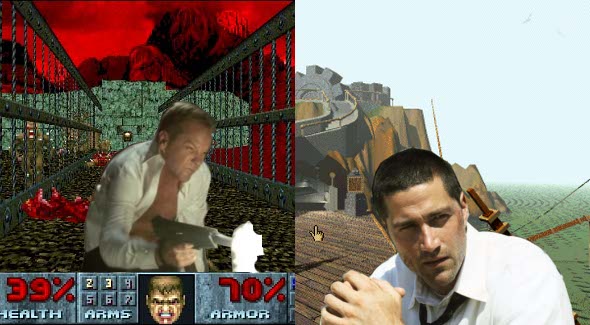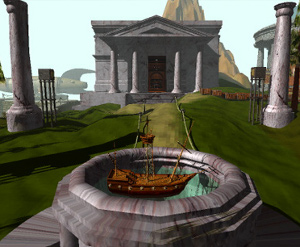Jack’s New Era in Exploration
I’m kind of astounded by the number of people I’ve talked to these days who don’t remember MYST. For the youngins out there, MYST was a very confusing but oddly peaceful adventure where you moved around this island and other “ages” clicking on stuff, manipulating it until other stuff happened, all driving toward a goal that you weren’t that sure about when you started the game. You had to read books in-game; as in, turn the pages and pore through of old vellum codices, finding the secrets of a great traveler or wizard named Atrus and his two sons, one friendly-ish, one more sinister. It was as much about discovery as about victory – the journey as much as the destination.
MYST was also the best-selling computer game of all time by a pretty big margin until The SIMS ousted it in 2002. If you bought a Mac or PC in the mid-90s, it may very well have come with MYST (my 486 did).
But when you got MYST, you generally got it on a CD-ROM, which at the time of MYST’s release was still a new and not particularly widespread technology. The CD-ROM allowed for the storage of what at the time was voluminous quantities of data. The CD-ROM was a huge, huge leap forward in our ability to do a lot of things, like read encyclopedias (ah, Encarta), have entire atlases of road maps available to click through for the first time (ah, Rand McNally TripMaker) or play games that were so far beyond what was previously possible that they sometimes didn’t know what to do with it (ah, Night Trap. Ah, Cosmic Osmo.).
The introduction of the CD-ROM is where the capabilities of modern home computers, laptops and smartphones begin to start looking somewhat recognizable. Beforehand, well, there were 3½” or 5¼” floppies, and to play even a really crappy game in the 90s, you sometimes had to install eight or nine of the little guys on your hard disk.
But enough about that nostalgia – the main point is that a CD-ROM was what really took the idea of computerized exploration and made it not so much possible as practical for the public. Beforehand, yeah, you had text adventures with a lot of depth, or dungeon crawlers that generated from a seed or went on forever, but the cognitive imaginative leap was considerable. With a CD-ROM, you could have free-roaming worlds in 3D with hours and hours of things to explore. Somehow a huge world could shrink down and fit on a disk. It changed people’s notions about how to conceive of the mutability of the universe.
OR …
Jack’s New Era in Combat
Most people I’ve talked to remember DOOM, probably because of the art film of the same name that came out a few years ago, starring the Rock and McCoy from the new Star Trek movie. The movie is a piece of crap, but it has this totally awesome scene in it, where our hero goes all super-soldier first-person shooter all over the place (WARNING: CHAINSAW-RELATED GORE):
http://www.youtube.com/watch?v=cpb13mDBP1I
If the whole movie had been like that, it at least would have been an interesting art object. Sadly, it has a plot. A very bad plot.
Back in 1993, in the DOOM computer game, you are a space marine (what a strangely specific thing of which our culture has provided so many examples), left behind by your buddies in a mission to check out a strange event on one of the moons of Mars. It turns out scientists, while experimenting with teleportation technology, have opened a portal to Hell by accident (which is also the plot of the awful movie Event Horizon). All your buddies die or are converted into demons or zombies by the surging evils of Hell spewing forth onto this moon. Armed only with a pistol – and about a zillion guns you manage to pick up that are just lying all over the place very conveniently, you must shoot your way through wave upon wave of Hell monsters, teleporting yourself eventually into another dimension, to make war on Hell itself.
Oh, and it looked like this:
Sure, HALO (what’s with all these capital letters and four-letter titles. Is somebody naming Final Fantasy characters?) is a lot fancier, but you can recognize the gameplay starts to feel contemporary, especially if you compare it to its mama, the first-person shooter (FPS) genre pioneer Wolfenstein 3D (WARNING: ROBOT HITLER).
Without the vertical movement, the game world is not nearly as fully realized – it feels much closer to old styles of maze PC games than newer FPSes.
MYST wasn’t the first CD-ROM world-exploration adventure game. But it was the great leap forward – it popularized the type of game.
DOOM wasn’t the first FPS to plunge the player into a world of guns and blood. But it was the great leap forward – it popularized the game.
And much like MYST was the greatest-selling game of all time in its day, DOOM was peerless. In 2004, 11 years after its initial release and a few seasons into the run of a little show called 24 that played a lot like a first-person shooter itself at times, DOOM was voted by GameSpy as the #1 greatest game of all time.



In a way, yesterday was the final Mortal Monday.
This is interesting, because 24 was originally slated to debut in 1994.
This article is awesome and I love reading it and others like it on your site. For the podcast could you just have the author read the article first? That way I could skip over the part where you all giggle and hem and haw about yourselves for half an hour before getting to any content.
Wow, did we just get neg hit?
Was there ever an episode of 24 where Jack entered a cheat code and became immortal and had every weapon available to him including a big gun that shot out a pulsing blue light and also he could walk through walls? Because that would really tie that connection together.
@Chris
Yes. Jack Bauer seems to use that code about three times a season. This time around it involved Michael Madsen.
Really interesting; the exploring mysterious island & linearly fighting demons paradigms both seem quite accurate. But I’m not sure I buy that “24 and Lost are ending therefore we’ve figured something out as a culture.” Might it not just be a fortuitous coincidence?
from what i’ve seen of Lost they always are moving and running and fighting but not getting anywhere… trying to impose linear time on a non-linear narrative?
and Hurley, who seems to just wait in the background, comes out on top
But do you shoot *polar bears* in DOOM? Therein would lie the ultimate connection, sir Fenzel.
;p
When I was halfway your article I couldn’t help but think of Doom and 24 as taking place in an ‘island in time’: the now. One thing you don’t mention about Myst is that you could only move through it screen by screen – no fluid 3d animation, but more like Colossal Cave with pictures. So the spatial constraint was double (no getting of the island, no free movement). So you could say that Myst/Lost requires spatial constraints to explore temporal questions and that Doom/24 has temporal constraints to freely explore space/spatiality. So now I finally understand how Jack Bauer can travel across LA in 15 minutes. Thanks for clearing that up!
OK, I’ve been waiting to do this for a while:
WELL ACTUALLY the Highlander series fills the 1 am (EST) low budget action hour.
Still, I would like to see more on the progression of Jack in our media.
A bit late commenting on this article, but I wanted to add more relevant cultural context to this pre-gamergate article…
MYST holds a special place of nostalgia for those of us who craved accessible content in the ’90s, but that does not mean the franchise gets a “free pass” from criticism or exemption from censorship. The games still employed sexist tropes and game mechanics that enforced/internalized misogynistic ideology (granted, to a lesser degree than other games at the time) in the individual minds that were participating in this male-created adventure. The supplemental books and comics that were released were a little better in their depiction/treatment of female characters, but not by much, and managed to gain a cult-like following amongst the less developed minds of that generation. It would have been better for all if MYST was sequestered to the nostalgic past, but in the last two decades, there have been attempts to resurrect the franchise onto the “big screen” in the form of a movie or series. These attempts have mostly self-destructed under poor management, but the project keeps getting passed to larger studios, and I would be lying if I said I was not worried about the continued proliferation of ’90s era game misogyny to modern media. We are/were too late to stop another Mortal Kombat, but we can stop this. If you consider yourself to be a feminist, please consider signing this petition to “cease any-and-all progress on creating a movie or TV series based on the misogynistic video game franchise of Myst”
[ https://www.change.org/p/stop-movie-based-on-sexist-myst-video-game-series ]
Even if they modernize the content for the movie or series, people will possibly want to explore the source material and ingest the inherent sexism therein. It must end. As my favorite line in the new Star Wars movies suggests, we must “let the past die. Kill it, if you have to.”
Please note, I am not the author of the petition, but I do believe in it.